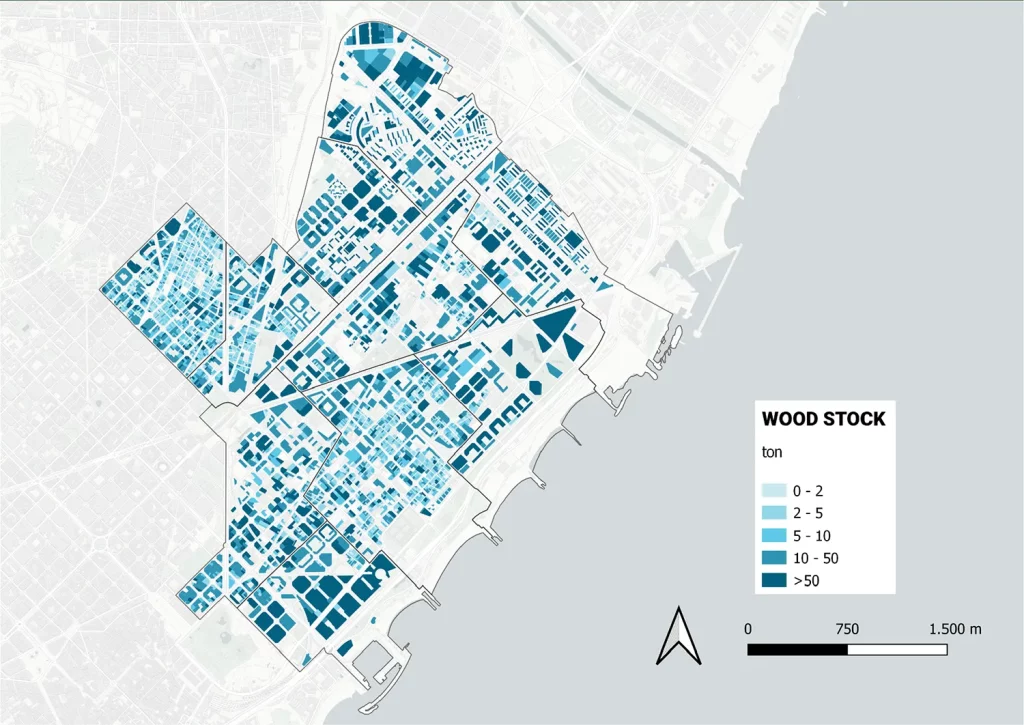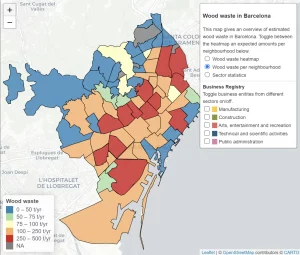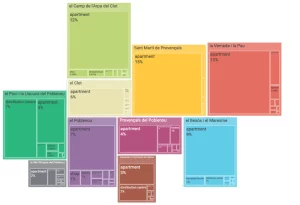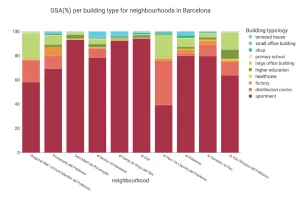BLOG
Mapping the wood stocks in Poblenou’s buildings
Mapping the wood stocks in Poblenou’s buildings
Mapping the wood stocks in Poblenou’s buildings
Circular economy opportunities for reusing wood resources in Poblenou – Barcelona
Words by IAAC & Metabolic
ABOUT THE PILOT AREA
Pilot area: El Poblenou?
Fab Lab Barcelona and IAAC have set out to map local makers and wood resources in Barcelona’s former industrial hub El Poblenou to spot opportunities for a circular urban transformation. The goal of urban ecosystem mapping in El Poblenou is to showcase the wood resources hidden in the neighbourhood’s urban mine and draft out policy proposals that support the recovery and reuse of demolition waste wood by local wood industries.
Introduction
Poblenou is a neighborhood situated on the north-east of Barcelona, in the district of Sant Martí. It was considered one of Spain’s most important industrial areas, known in the past as “The Catalan Manchester”. Since the late ’60s has suffered a profound deindustrialisation process, leaving behind its characteristic working-class community fabric as well as many empty lots warehouses. After a period of decay, Poblenou underwent a strong territorial transformation, with the 1992 Olympic Games being the main trigger for this change. On account of its organization, dozens of commercial facilities as well as streets and industrial spaces were demolished. Since then, Poblenou has been a testbed for different urban visions, such as the “Forum de las Culturas” in 2004, or the first Barcelona superblock implemented in 2016. The BIT Habitat (Barcelona Institute of Technology for the Habitat) agency, opened its doors in Poblenou also in 2015.
 Image 1. Source: Fab Lab Barcelona
Image 1. Source: Fab Lab Barcelona
In 2000, Barcelona city council launched the 22@ plan, which fostered the transformation of Poblenou as a new technological district. Since the approval of the plan, and more intensely after the pandemic period in 2021, national and international companies, service businesses and innovation start-ups have been attracted to set up their headquarters in the district.
?
While some companies and public facilities were more interested in preserving Poblenou’s heritage identity by adapting old factories and combining them with innovative architecture, some international companies demanded modern headquarters with technology facilities. As a result of these urban transformations, many old buildings in Poblenou have to give way to new construction – a process that leaves behind demolition and construction waste. While it is difficult to find numbers just for Poblenou, Catalonia as a whole has generated over 5 million tons of construction waste in 2019 – twice as much as in 2013. Along with the disappearance of historic buildings and the emergence of new businesses, the manufacturing profile that played a very important role in the past has also been replaced by service and technology companies and consequently has lost visibility and presence in the neighborhood. However, even with barriers for production licenses and increasing rental prices, Poblenou contains an important variety of local manufacturers, material providers, and production spaces. These actors, who are often found hidden inside old factories, sharing industrial spaces, and following collaborative models, are key to fostering local production and a regenerative circular economy.
Identifying fabrication facilities, craftspeople, and manufacturers will play an important role in understanding the potential for circular practices in this district. In parallel, we seek to understand what types of material are being used, re-used, and wasted in order to identify opportunities for intervention. We decided to focus our research on wood use and wood waste because it is used, re-used, and wasted in large quantities. In addition, numerous woodworkers and carpenters work in the district and could play a role in implementing new circular strategies with the material. We aim to map and understand the availability of wood from the demolition and construction sector, and to identify the potential for reuse of these materials by manufacturers in the neighborhood.
The Barcelona pilot mapping strategy
To understand the potential of circular wood production for Poblenou and Sant Marti district, we adopted both a birds-eye view on urban wood waste, as well as a close-up deep dive into local wood resources within our community’s businesses. With this complementary bottom-up and top-down approach, we can begin to understand the complex social connections and knowledge exchanges among actors and to analyze barriers and opportunities for a local circular economy. The collected data has been organized, visualized and analyzed into different map views on the interactive KUMU platform.

How have we approached this task? First of all, we started with a bottom-up approach by interviewing local producers, makers, creative spaces and local businesses who were interested in joining Make Works [1] Catalonia, an online platform that aims to make local manufacturing more accessible. During each interview and site visit with local manufacturers, we record the types of materials used for production, waste materials generated during production, their machines, their processes, their traditions and other capacities and skills. The aim is to grow the Make Works Catalonia community while also identifying manufacturers [1] potential role in improving material circularity.

Image 2. List of manufacturers of Catalonia on the Make Works website. Source: MakeWorks
For the top down mapping, we developed a contextual picture of wood stocks in the district that includes a broad analytical scope and a more robust methodology. Together with Metabolic Institute, the Barcelona pilot carried out an urban mining analysis for the Sant Martí district that initially focused on wood recovery. Following a model developed during a previous research project by Metabolic and in collaboration with SGS Search [2], nine different building typologies were considered (including apartment, terraced house, distribution centre, small office building, large office building, primary school, higher education facility, healthcare facility, factory and shop) and assigned to 6484 items in the district. With this data, and based on initial assumptions, it was calculated that a total of 168 kilotonnes of existing wood is present in the selected buildings of Sant Martí (equivalent to enough material to build 258 Eiffel Towers!)
 Map 1. Estimation of wood stock per building in the Sant Martí District. Source: Metabolic
Map 1. Estimation of wood stock per building in the Sant Martí District. Source: Metabolic
Figure 1. Wood stock distribution over the neighborhoods in the Sant Martí District. Source: Metabolic
Figure 2. Percentage of the Sant Martí’s total Gross Surface Area per building type. Source: Metabolic
As a result of the preliminary mapping analysis of the Sant Martí district, we identified some challenges and great opportunities for the implementation and improvement of circular material use in the territory
?
Challenges
The reuse and recycling of wood from the construction and demolition sector would require proper management of these materials by specialized companies. Currently, the district lacks services that specialize in handling high-level recycling material in the district, and a waste material recovery plan is unknown.
Besides some initial project ideas for managing reused materials in the territory, such as the 22@ scrapstore, the district does not have a storage site for recovered materials. Logistics and scheduling will also become essential to ensure that materials are picked up and stored in a timely manner. The varying qualities of materials will dictate what it can be used for. For example, wood that has been exposed to the elements for several decades may lose its strength and resistance, and consequently, will no longer be suitable for its original application (e.g. wooden windows) or other similar uses according to local legislation and standards. This is where small-scale urban manufacturing comes in!
?
Opportunities
If it is not possible to take advantage of its original use as a building element, local manufacturers, architects and experts could put this valuable raw material to new uses or transform the waste into new materials. Urban manufactures can leverage their local presence, skills, machinery, and space to implement innovative and circular strategies on a neighborhood scale. For example, they could use recovered building elements in their manufacturing practices or temporarily store high-value demolition materials for other makers or manufacturers to put to use. Wood from demolition could be reused for new building structures, or ground up and transformed into wood-based panels.
Extending the lifetime of materials in the system as well as increasing the reuse of existing resources will provide new possibilities for the market, develop diverse products or services, and encourage collaboration between local actors. The availability of materials to be recovered in the territory could also encourage the return of local production to the urban landscape, generating employment opportunities, not only for production, but also for the management of storage spaces (for example, by social organizations). In order to further foment this transition, these circular strategies could be incorporated into educational institutions through primary and secondary school curriculums, university study and research grants. We explore these opportunities for material circularity and social innovation using the Kumu map as a visualization tool. With a focus on wood and wood waste, we have mapped out potential and existing actors and connections that illustrate the potential for circular material flows and transfer of knowledge and skills. The majority of the connections featured in the map have not yet been put into action but some of the mapped connections are existing and we recognize that there may be many other existing connections that we are unaware of. This PRESENTATION walks us through the different stages of the use and re-use of wood and wood waste for education, material development, large-scale fabrication, and for urban gardens. Other potential connections for the reuse of demolition materials have been mapped by the pilot and are exemplified in the format of ‘circular’ mapping stories’.
Makers & Materials in Poble Nou & Sant Martí
Starting with a bottom-up approach, we located makers, craftspeople, fabrication facilities, shared workshops, and material providers in the district. We identified which materials each facility or organization uses and plotted out many connections (both existing and potential) between these facilities. Each color on the map refers to a material type. You can toggle through the materials at the top to filter the results. See the map here.
Next steps
The connection between top down and bottom up analysis allowed the Barcelona pilot to identify opportunities for materials recycling, business creation, product development and potential policy proposals. The next steps of this applied research will focus on creating strong evidence and communicating, by tailoring for each target group, how these opportunities could be brought to reality.
The results from the initial urban mining analysis might be combined with an assessment of municipal demolition data in order to estimate the amount of wood available from construction and demolition waste in the neighborhood in the coming 2 to 5 years. In parallel, we will explore potential uses, products and other building elements that could be made out of recycled wood from the construction and demolition sector. This assessment will be done in collaboration with the Make Works Catalonia manufacturers, wood experts, universities, architects, and other identified makers. The research will also consider showcases from other countries to exemplify possible business opportunities such as the charity and social enterprise Glasgow Wood, or the Community Wood Recycling in the UK, who create wood furniture and accessories from reclaimed timber.
Lastly, the information gathered through the analysis could be used for the development of policy briefs based on opportunities for recycling wood at a local level. The pilot aims at engaging with the local government, who plays a key role in implementing measures to increase re-use and recycling for the construction and demolition sector. By providing the representatives access to the CENTRINNO ecosystem mapping results, our goal is to support local manufacturing while influencing the adoption of sustainable policy practices for recycling and reusing local resources. We see great opportunity for Poblenou and Sant Martí district to be recognized, not only as a technological district, but also as circular and regenerative neighborhoods.
Authors: Milena Calvo Juarez and Julia Steketee (IAAC)



































































































